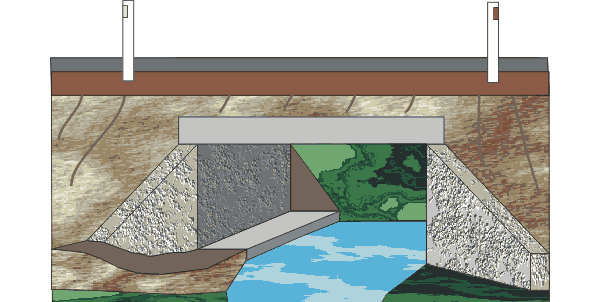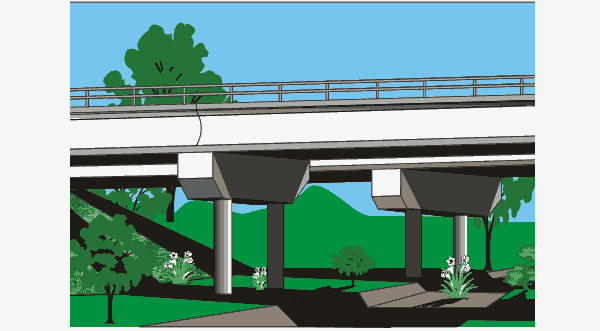Design of Fauna Underpasses
Table of Contents
1. General
This document shall be used as a guideline for the design of fauna underpasses. The concept of fauna underpasses is not new and has been receiving increasing attention in recent years. Knowledge regarding the installation and use of fauna underpasses is continually increasing, based on experiences in Australia and overseas. Consequently, much of what is proposed in this guide is based on the experience in Australia and first principles of animal behaviour. Main Roads’ Environment Branch maintain a list of projects that have installed fauna underpasses and can be contacted for more information on the subject.
The fundamental aim of fauna underpasses is to allow native animals unrestricted access to habitat that has been fragmented by the construction of a road. Under the West Australian Wildlife Conservation Act 1950 and Conservation and Land Management Act 1984 there is an obligation to protect fauna and flora where possible. Habitat fragmentation can also increase the numbers of feral predators such as cats and foxes who will also use the fauna underpass and prey on the local native fauna. This is just one of the many factors that will need to be considered in the planning of a fauna underpass.
2. Design Considerations
The fauna underpass should be designed to cater primarily for the fauna species at risk of habitat fragmentation. On advice from DEC and if practical the underpass may also cater for a wider range of fauna. This requires some knowledge of the range of native fauna inhabiting the area, and may require surveys to be conducted in a number of seasons to allow identification of the important species (e.g. survey for amphibians in winter-spring, reptiles in summer-autumn etc.). Fauna management specialists and the DEC will be able to provide advice on the required fauna studies and underpass designs.
The dimensions of the underpass should be relative to the size of the animals that will use it. In Western Australia the largest species likely to use underpasses are kangaroos and wallabies. Catering for larger species may require substantial engineering works to allow for an underpass between 800mm to 1800mm in height (internal height). Recent studies have shown that in conjunction with fencing leading kangaroos to the underpass, they will crawl through relatively small diameter culverts.
Generally terrestrial fauna prefer a dry route from one side of the carriage way to the other. If there is an issue with maintaining the underpass dry then ramps or raised ledges may be an option within the underpass to allow dry passage. See Figure 1 for an example of a ledge.
If terrestrial mammals are not present in the area and there is no likelihood of them re-colonizing the area it may be possible to construct the underpass so that it becomes part of a drainage structure. If used as part of a drainage structure or in addition too drainage structures nearby, the underpass should be designed to be self draining so as not to allow ponding of water.
If the underpass is to provide passage for water borne fauna then it would be practical to design it as a drainage structure. If this is the case the invert level of the culvert may need to be lower or rock riffles installed to the base of the drainage structure. Refer to Main Roads guidelines on the Culverts web page and consult with Structures Engineering Branch if non standard changes to the drainage structure are proposed.
Main Roads typically uses drainage structures such as culverts for underpasses. Typical drawing details of Main Roads culverts can be found at the Standard Drawings web page.
Whenever fauna underpasses are part of a project DEC shall be contacted. DEC can advise on individual species needs in regards to:
- Fauna species and habitat requirements,
- Migratory patterns of the fauna species,
- Underpass size and spacing requirements, and
- Underpass slope/grade requirements for fauna species.
2.1 Types of Fauna Underpasses
Underpasses usually take the form of a culvert, refer to Figure 1, but sometimes an underpass may be under a bridge structure. Culverts are the most suitable for fauna passage and allow the free movement of a wide range of native species. Culverts suitable for terrestrial fauna should provide dry passage conditions for the majority of the time. Culverts may be either singular or multiple, round or box sections and of various radii or rectangular box dimensions.
2.1.1 Underpasses with Surface Grills
Where underpasses cross very wide roads (i.e. dual carriage ways) surface grills at the midpoint will allow light and airflow into the underpass and make the passage more acceptable to fauna. The entry of light into the underpass should not bother most native species as a high proportion are nocturnal. However a negative of the installation of skylights is that it would most likely encourage the use of domestic and feral predators during daylight hours (Queensland Department of Main Roads).
Any grill or skylight that may carry traffic or present the possibility of vehicles crossing over it, for whatever reason, shall be designed according to Classification Class D as per AS 3996.

Figure 1 Example Culvert as Underpass
2.2 Fencing
2.2.1 Perimeter Fencing of Underpasses
The aperture of most underpasses will be quite small in relation to the ground area over which most species of fauna will range. To maximize the potential use of the underpass and to help prevent fauna moving onto the roadway it is possible to install fences. The fencing aides to direct any animals moving towards the roadway along the fence line and towards the entrance to the underpass. In areas supporting kangaroos and wallabies the fences may need to extend several hundred metres either side of the entrance to the underpass, with the last 10-15m of the fence angled in towards the entrance. The fencing arrangement must be constructed on both sides of the roadway to maximise entry of fauna on both sides of the underpass and to prevent animals being trapped on one side of the road way.
2.2.2 Fence Aperture Size
The specifications of the wire mesh on the fence will vary depending on the species of fauna that the underpass is intended to cater for. Large mammals such as kangaroos and wallabies can be channelled towards the underpass with galvanised chainwire mesh fencing, while small mammals, reptiles, amphibians and even invertebrates will need smaller diameter mesh (e.g. aviary mesh). Refer to Standard Drawing 200331-110 and Main Roads Guide to the Design of Fencing and Walls.
2.2.3 Fence Ground Treatments
When some species of fauna encounter fences their first reaction is to try and dig under the fence. If the fence is to serve its purpose of preventing the animals from entering the roadway and running the risk of collision with vehicles, then the mesh netting also needs to be partially buried below the ground. While many animals will try to dig under fences they seldom dig very deep or begin digging very far from the fence line itself. The mesh need only be buried 350 mm below the surface and back-filled. Refer to Main Roads Standard Drawing 200331-110. Where the fence cannot be buried i.e. in rocky ground or around the wing wall/head wall of the underpass, it must be securely pined to the ground to prevent fauna crawling under the wire, especially underpasses designed for kangaroos.
Another example is in areas where rabbits are present and the likelihood of them digging under fences is high, the integrity of the whole system can be compromised. In these cases it is prudent before backfilling to fold the lower edge of the mesh out at 90 degrees from the fence line and burying it below ground. If gates are present in the fence then the ground below the gate needs suitable protection treatments. One solution is to place concrete at the base of the gate along its length.
- Ongoing maintenance of the fence is important if the underpass is to continue to function at an optimal level. Issues which need to be considered are:
- Vegetation needs to be kept clear of the fence line to minimise the number of uncontrolled crossing points.
- Fence posts and strainers need to be checked regularly.
- Fencing in any areas with moist soil, such as near watercourses, need to be checked to ensure it has not corroded away.
- Any defective sections should be replaced as soon as possible or practical.

Figure 2 Fauna Underpass using a Bridge
2.3 Encouraging Fauna to use the Underpass
A project specific environmental management plan is essential to address environmental concerns surrounding such issues as Habitat Fragmentation and plausible solutions such as Fauna Underpasses. Environmental Management Plans can also identify other issues concerning fauna underpasses, their location, construction requirements, commuting fauna species and their requirements for flora species. The following notes are meant to be an aid to enhancing the potential use of fauna underpasses.
2.3.1 Location of Underpasses
Every effort should be made to locate the underpasses in areas of high quality habitat and/or high fauna activity. These areas of high usage can usually be identified during the fauna surveys. Areas of high fauna activity are often found along the edges of watercourses, and along the boundary between woodlands and shrub lands where there is a change in habitat.
Underpasses should be located in the known migratory path of fauna or the known traditional travel paths of fauna. Otherwise the fauna is at risk of crossing at the road rather than using the underpass and this may increase the mortality rates.
Where a bridge is proposed to also act as an underpass, consideration should be given to providing a clear view for fauna from both sides under the bridge and some part of the underpass should remain dry for terrestrial fauna. Refer to Figure 2.
2.3.2 Underpass Floor Base
To encourage use of the underpass by fauna it should provide a dry passage and the base surface should be covered in natural materials and soil from the surrounding area where possible or at a minimum with sand.
To maximize the likelihood of fauna using the underpass small rocks and logs need to be added in order to blend the whole structure into the surrounding landscape. This will provide a natural feel to the underpass and will provide temporary shelter to any fauna passing through the underpass.
2.3.3 Entry Landscaping
The entrance to the underpass should have local indigenous plant species to provide safety and protection to approaching fauna and uniformity in surroundings.
Native vegetation, ideally grown from seed collected locally that provides a low, and in some places, dense cover could be planted in the area leading up to and away from the underpass. This provides shelter and better possibility of food for any fauna moving along the barrier fence and underpass. It also reduces the prospect of the whole area being avoided because of the unnatural conditions left following construction of the roadway.
2.3.4 Entrance Grills
The use of grills at entrances of an underpass may be useful when the risk of predators pursuing fauna is evident. Grills shall be designed according to the advice given by DEC for the selected species to use the underpass and those species that the grill is to protect the underpass from. For larger underpasses the installation of vertical bars at a set width might be required in the middle of the underpass to keep out bikes and other off road vehicles.
3. References
- "Fauna Sensitive Road Design: Past and Existing Practices" Queensland Department of Main Roads (2000).
- Australian Standard 3996 - Metal access covers, road grates and frames.
- “Roads versus animals: how can we maximise the effectiveness of fauna underpasses and minimise road kills?” West, Paul and Bencini, Roberta and Della Bona, Jeanette (2007).
- “Evaluation of the Use and Effectiveness of Wildlife Crossings – NCHRP Report 615” Transportation Research Board (2008)